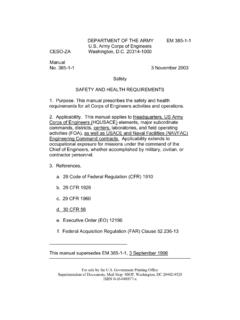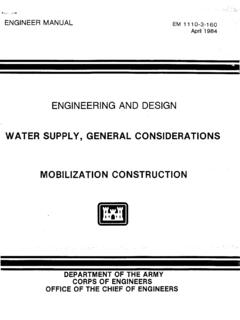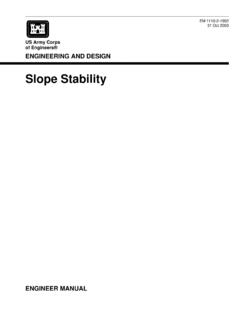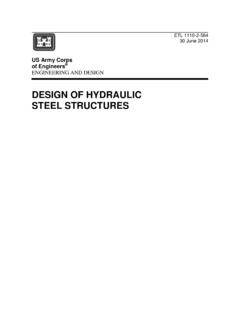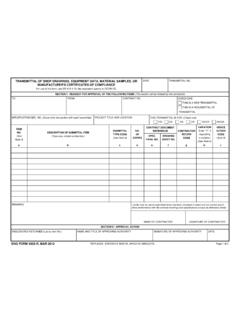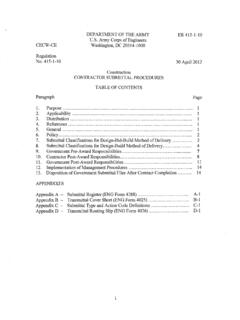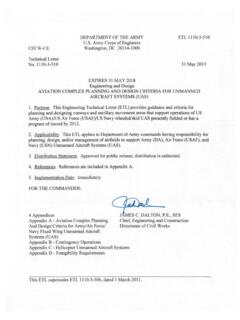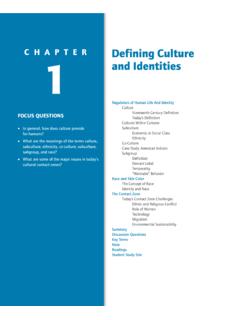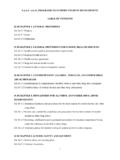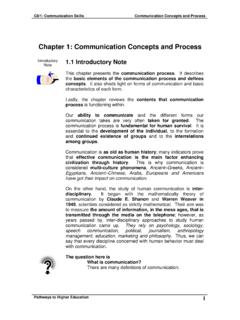Transcription of EP 310-1-6 Graphic Standards Manual - United States Army
1 US Army Corps of Engineers . Graphic Standards Manual EP 310-1-6 Revised 9/94. DEPARTMENT OF THE ARMY EP 310-1-6 . Army Corps of Engineers Change 1. CECW -CO Washington, DC 20314-1000. Pamphlet No. 310-1-6 1 June 2006. Corporate Information Graphic Standards Manual . 1. This Change 1 to EP 310-1-6 , September 1994 changes the point of contact for the Army Corps of Engineers Sign Standards to the district, division sign program manager or the National Sign Program Manager located at the Sign MCX in the St. Paul District. 2. Substitute the attached page as shown below: Chapter Remove page Insert page 6 6-1 6-1. 3. File this change sheet in front of the publication for reference purposes. FOR THE COMMANDER: Colonel, Corps of Engineers Chief of Staff A Message From the Commander I. The guidance provided within this Graphic Standards Manual was developed to assure that the visual presen- tation of the Corps of Engineers is accomplished with consistency and forethought.
2 Set forth for your refer- ence are the current policies regarding the use of the Corps logotype and direction on the development of visual communications. Continuing to focus on the Corps Communication Mark and its various applications, the Manual also introduces guidance for new areas where Graphic identification of the Corps is appropriate. The Manual is designed to be a useful tool for develop- ing visual communications for Corps programs. Whether the medium is a brochure, poster, newspaper or video, the necessity of presenting a consistent, recognizable image to the public, as well as our employees, is important to the Corps tradition and its continued service to our nation. I urge you to become familiar with the content of these pages and the appro- priate applications demonstrated.
3 Arthur E. Williams Lieutenant General, USA. Commanding Table of Contents II. Message From The Commander ..I. Table of Contents ..II. Chapter 1. Communication Mark and Signature ..1-2. Chapter 2. Heraldic Symbology ..2-1. Chapter 3. Publications ..3-1. Chapter 4. Publication Grids ..4-1. Chapter 5. Business graphics and Forms ..5-1. Chapter 6. Signage ..6-1. Chapter 7. Vehicles ..7-1. Chapter 8. Miscellaneous ..8-1. Chapter 9. Reproduction Art ..9-1. Communication Mark 1. and Signature The Communication Mark 1-1. The Army Corps of Engineers Communication Mark is the key Graphic element in the Corps' uniform Graphic identification system. Its form is derived from the traditional castle symbol used by Corps since its inception. The mark has been redesigned to have greater strength and adaptability, both visually and for reproduction purposes.
4 In its new form, the mark is a simplified con- temporary rendering of a traditional symbol. This mark is well suited for use in a wide range of identification, promotion and advertising applications aimed both at internal Corps audiences and at the gen- eral public. The shapes contained within the mark have been rendered for clear reproduction at both large and small scales. The mark is primarily used as the com- mon Graphic element placed above the names of Field Operating Activities within the Corps as a part of their signatures. The mark may stand alone on publication covers, and other Corps graphics as a tasteful visual element. It should not, how- ever, be used decoratively on the same page or surface that contains a full signa- ture. When using the mark by itself on a publication, place the full signature in another appropriate position, such as the back cover, book spine or title page.
5 Some notes to remember when using the mark: The mark has been carefully drawn and should only be reproduced by photographic processes from the approved reproduction art in Chapter 9 of this Manual . If the mark must be produced at a scale too large for photographic reproduction, a grid drawing of the mark is provided on page 9-5 of this Manual . The mark should never be reproduced at less than 1 4" in height. The mark shall only be used on its proper axis and never rotated to a new position. Refer to approved reproduction artwork in Chapter 9 of this Manual . No prior versions of the Corps mark may be used except as outlined in section 2 of this Manual . No Division, District or other Field Operating Activity symbols, marks or sig- natures may be used. Contact the Graphic Standards Coordi- nator, HQUSACE, CEIM-IV, for advice and assistance concerning specialized or unique applications of the mark.
6 Upon request, the Communication Mark, as well as other Graphic symbols used by the Corps for visual identification, are available in diskette format. The Communication Mark has been registered with the US Patent and Trademark Office on November 30, 1993. as registration NO. 1,807,986. The . symbol is to be displayed with the mark when reproducing printed promotional material that is intended for public usage. Basic Configuration of the Mark 1-2. There are three preferred configurations of the Corps Mark and Signature which are shown at the right. These basic forms have been developed to provide maximum flexi- bility in the use of the mark and are the basis for the Tone and Color Useage Guide on page 1-5 of this Manual . One-Color Version In many print applications, only one color will be available to the designer.
7 The mark and signature as well as other typography and illustration, in such cases, require that the color used have a dark value. Black and dark values of the primary or second- ary color are preferred. Avoid the use of pastel, diluted or thin colors in these applications. Two-Color Version Where two flat colors or four-color process colors are available, the mark may be shown in Communication Red while the name of the Corps and activity are shown in black against a white background. Swatches for matching Communication Red are found in Chapter 9 of this Manual . In four-color process, Communication Red may be achieved by printing solid magenta/80% yellow in combination. Reverse Version Because of the nature of the drawing of the positive version of the mark (as shown above), a normal conversion to negative will result in a black rather than a white castle.
8 To avoid this situation, a special drawing of the mark has been developed which includes an additional white outline. Only the reproduction artwork provided in Chapter 9 of this Manual shall be used to show the mark in reverse. Color considerations are similar to those described for the One-Color Version. In certain situations, shown throughout this Manual , the reverse treatment may be used showing the Communication Mark in Communication Red. Signature Configurations 1-3. The primary purpose of the signature is to graphically identify the Corps and its Field Operating Activities in a uniform and communicative way. All signatures are a combination of the Corps Mark and the name which describes a specific Field Operating Activity. No additional elements, typography or Graphic devices should ever be added to the basic signature configuration.
9 Corps Signature The Corps Signature consists of the mark and the Corps of Engineers name set in the Helvetica Medium type face. Both elements are placed flush to the left. This signature is to be used as the Graphic identifier on those items common to the entire Corps of Engineers. Division, District and other Field Operating Activity Signatures There are individual signatures for the Office of the Chief of Engineers and for each Field Operating Activity in the Corps. The Corps Signature is the principal Graphic identifier to be used by these activities on all publications, signage, vehicles, etc. The individual Field Operating Activity signature is a modification of the basic Corps Signature. It is formed by placing the name of the particular FOA below the Corps name. FOA names are set in Helve- tica Regular, a lighter-weight type face so that, while emphasis remains on the Corps name and mark, each Corps activity is identified in its own unique identification signature and, at the same time, is clearly related to the Corps as a whole.
10 There are no other acceptable versions of the signature. Do not alter the typogra- phy, mark size, or general configuration of the signature. Use original reproduction artwork found in Chapter 9 of this Manual at all times. Avoid second generation reproduction. For detailed guidance on the application or use of the signature, refer to the appli- cable sections of this Manual . Contact the Corps graphics Coordinator for advice and assistance on unique or special appli- cations of the signature. Color Standards 1-4. Two standard colors have been designated for the Corps graphics program. Communication Red is to be used in all color versions of the Corps Communica- tion Mark, as well as in other applications illustrated in this Manual . Communication Gray may be used as a second color for typography in two-color versions of the Corps signature and may also be used as a single color in certain situations.

